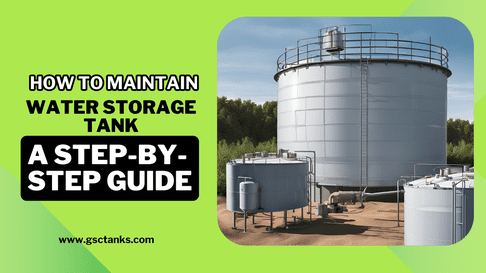
- admin
- November 28, 2024
How to Maintain Water Storage Tank: A Step-by-Step Guide
Water storage tanks supply clean and safe water for various uses. Regular maintenance keeps your tank functioning efficiently and ensures water quality. This guide provides simple yet effective steps to help you maintain your water storage tank.
1.Inspect the Tank Regularly
Start by inspecting your water storage tank for visible damage, including cracks, leaks, or rust. Examine the interior and exterior surfaces closely. Regular inspections help you identify potential problems early.
2.Clean the Tank Periodically
Start by inspecting your water storage tank for visible damage, such as cracks, leaks, or rust. Examine the interior and exterior surfaces closely. Regular inspections allow you to catch potential problems early.
3.Check for Sediment Build-Up to Maintain Water Storage Tank
Inspect your water storage tank first for visible damage, such as cracks, leaks, or rust. Examine the interior and exterior surfaces closely. Regular inspections help you identify potential problems early.
4.Maintain the Tank’s Inlet and Outlet Pipes
Inspect your water storage tank first for visible damage, such as cracks, leaks, or rust. Examine the interior and exterior surfaces closely. Regular inspections allow you to identify potential problems early.
5.Protect the Tank from External Damage
Protect your tank from harsh environmental conditions to extend its life. Additionally, apply protective coatings or use UV-resistant materials to shield it from the sun. Also, keep the area around the tank clear of debris and vegetation.
6.Monitor Water Quality to Maintain Water Storage Tank
Always test the water quality stored in your tank. Moreover, regular testing ensures the water stays safe for consumption or use. Also, if you notice any unusual taste, color, or odor, clean the tank immediately.
7.Schedule Professional Maintenance
While DIY maintenance is important, scheduling professional checkups helps address complex issues that may remain hidden. Experts can identify structural weaknesses and other concerns, then recommend the right solutions.
Conclusion
Maintaining your water storage tank properly ensures both the longevity of the tank and the safety and quality of the water. By following these steps, you can maximize your tank’s lifespan and reliability.
If you need high-quality water storage tanks or expert advice, GSC Tanks is here to assist you. Contact us today to learn more about our solutions.
- How to Maintain Water Storage Tank: A Step-by-Step Guide
- Maintain Water Storage Tank
Category
- Above Ground Fuel Tanks
- Above Ground Gas Storage Tank
- Above Ground Storage Tanks
- Above Ground Water Storage Tanks
- Agricultural Tanks
- Chemical storage Tanks
- Diesel Fuel Storage Tanks
- Diesel Storage Tanks
- Exernal FloatingRoof Tanks
- Farm Water Tank
- Fiberglass Oil Tanks
- Fiberglass Septic Tanks
- Fiberglass Tanks
- Fiberglass Underground Fuel Storage Tanks
- Field Erected Tanks
- Floating Roof Tank
- Food and Beverage Tanks
- Fuel tank
- Industrial Chemical Storage Tanks
- Industrial Gas Tanks
- Industrial Plastic Tanks
- Industrial Storage Tanks
- Industrial Tank heating pads
- industrial tanks
- Natural gas
- Natural gas vs Propane
- oil storage tank
- Oil Storage Tanks
- Peracitic Acid
- Petroleum Tanks
- Residential gasoline storage tanks
- Residential Water Storage Tanks
- Sodium Hydroxide Storage Requirements
- Sodium Hypochlorite Storage Tanks
- Steel Storage Tanks
- storage tank failure prevention
- Storage Tanks
- Sulfuric Acid Tanks
- Uncategorized
- UnderGround Storage Tanks
- Waste water tank
- Water Storage Tanks

 Tank Size Calculator
Tank Size Calculator






